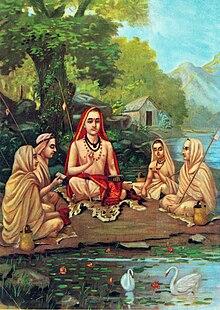Skip to main content
Thesis of Vedanta and a synopsis of Advaita
Vedanta & Advaita Vedanta

1. Introduction to Vedanta
- Vedanta is the most important and popular of the Vedic Darshanas.
- Focuses on the Upanishadic portion of the Veda (foundational text).
- "Prasthanatraya": Three foundational texts for Vedanta:
- Upanishads (concluding part of Vedas, account of Brahman, Atman)
- Brahma Sutras (philosophical sutras by Badarayana Vyasa)
- Bhagavad Gita (part of Mahabharata).
2. Sub-Schools of Vedanta
- Several sub-schools exist.
- Prominent ones discussed:
-
Advaita Vedanta: Popularized by Shankaracharya.
-
Vishishtadvaita: Propounded by Ramanujacharya.
-
Dvaita Vedanta: Propounded by Madhavacharya.
- Others include Shuddhadvaita, Dvaita Advaita.
3. Core Question of Vedanta
- What is the relationship between Jiva (individual self) and Brahman (ultimate reality)?
- Jiva : Brahman :: X : Y
4. Key Features of Advaita Vedanta
-
Relationship of Jiva & Brahman: Identity (A : A)
-
Jiva is identical to Brahman; there is no distinction.
-
Veil of Ignorance: This identity of jiva equal to Brahman is veiled by Maya or Avidya.
- Leads to the samsara chakra (cycle of birth and death) & attachment to objects.
- Removing this ignorance leads to realization of Brahman.
5. Moksha (Liberation)
- State where the Jiva realizes its true identity as Brahman.
6. Shankaracharya
- Main proponent of Advaita Vedanta (8th century).
- His teacher's teacher, Gaudapadacharya, wrote Mandukya Karika, which influenced Shankaracharya's theory.
7. "The World as We Know It" vs. "The World as It Really Is"
-
Vyavaharika Satta (Transactional Reality): “The World as We Know It” is the transactional reality, it is temporary. It is described as Mitya (False).
- It is not unreal or non-existent, it is a transactional reality (like a dream).
- Example: The world of our experiences, which is not permanent.
-
Paramarthika Satta (Transcendental Reality): "The World as What It Really is" it is true for all the three times. It is not Mitya but Satt.
- It is described as Satt which is true at all times.
- The Brahman is true for all times.
8. Attributes of Brahman
-
Nirguna: Brahman without attributes. It has no name or form.
- Opposes Saguna Brahman (Brahman with attributes, such as deities).
9. Process to Achieve Moksha (Realizing Brahman)
- Two-step procedure:
-
Purification: Engaging in Vedic karma (activities prescribed by Vedas) to purify the mind (chitta shuddhi).
-
Process to realization:
-
Shravana: Hearing the Upanishadic truths from a teacher.
-
Manana: Meditating on the teachings, removing doubts.
-
Nididhyasana: Contemplating and realizing the truth.
- Knowledge of the identity of Jiva and Brahman is experiential, not intellectual (not like math formula).
- It is not a becoming, it's already present and just has to be realized.
10. Nature of Moksha
- Not an event or process, but a state of being already present.
- Ignorance (Maya/Avidya) veils the Jiva's true nature as Brahman.
- Just like forgetting you have your glasses already on, Jiva forgets they are Brahman.
11. Relationship between Jiva & Avidya
- Jiva is already in the state of moksha.
- Ignorance needs to be unveiled to realize one's true state (as Brahman).

